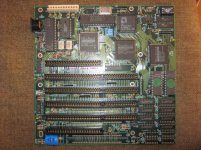Hello everyone,
I need the help of experienced people to debug some issues with the motherboard in the attached photo. I couldn't find an exact manufacturer or model - the closest one I found is this one (except for the location of the JP5 battery jumper and an extra JP6 that I have next to the FPU, they pretty much look alike):
http://stason.org/TULARC/pc/motherboards/A/AUVA-COMPUTER-INC-286-BABY-286-BAM-12-G1.html
The problem is that my board is pretty unstable (I'm using plain DOS 6.22 for testing). At first FDD access would hang the system (tested with three I/O controllers, two floppy cables and two FDD units), then someone suggested that I should remove the FPU, which I did - FDD access worked after that, but after putting back the FPU it was still working. Then I pulled out the eight 80ns RAM chips and put four 70ns chips - the system still worked, but FDD access broke again. Then I put back the original RAM chips - FDD still dead, lots of instability (freezes in games like Xenon2 or Volfied, hangs while doing nothing with Norton Commander open).
I sure hope it's the RAM's fault - is there any memtest-like tool available for pre-386 computers? I'd be very disappointed if something else were broken on the board, it's the first 286 board that I could get my hands on and I was really hoping to be able to build a system around it...
I need the help of experienced people to debug some issues with the motherboard in the attached photo. I couldn't find an exact manufacturer or model - the closest one I found is this one (except for the location of the JP5 battery jumper and an extra JP6 that I have next to the FPU, they pretty much look alike):
http://stason.org/TULARC/pc/motherboards/A/AUVA-COMPUTER-INC-286-BABY-286-BAM-12-G1.html
The problem is that my board is pretty unstable (I'm using plain DOS 6.22 for testing). At first FDD access would hang the system (tested with three I/O controllers, two floppy cables and two FDD units), then someone suggested that I should remove the FPU, which I did - FDD access worked after that, but after putting back the FPU it was still working. Then I pulled out the eight 80ns RAM chips and put four 70ns chips - the system still worked, but FDD access broke again. Then I put back the original RAM chips - FDD still dead, lots of instability (freezes in games like Xenon2 or Volfied, hangs while doing nothing with Norton Commander open).
I sure hope it's the RAM's fault - is there any memtest-like tool available for pre-386 computers? I'd be very disappointed if something else were broken on the board, it's the first 286 board that I could get my hands on and I was really hoping to be able to build a system around it...

